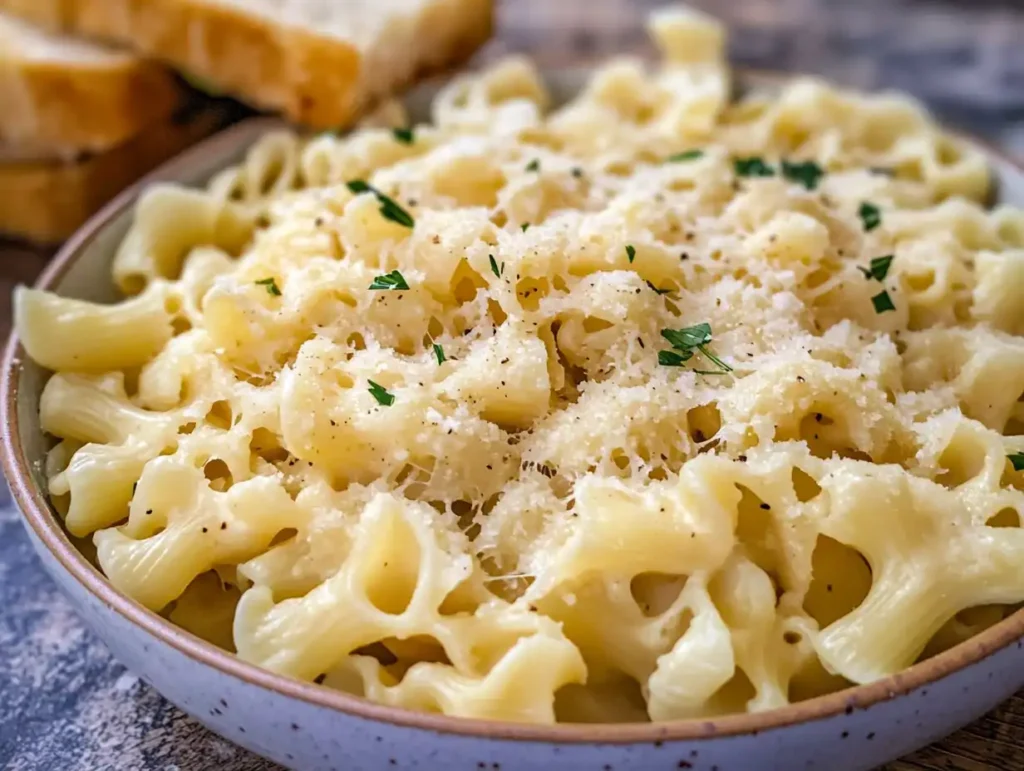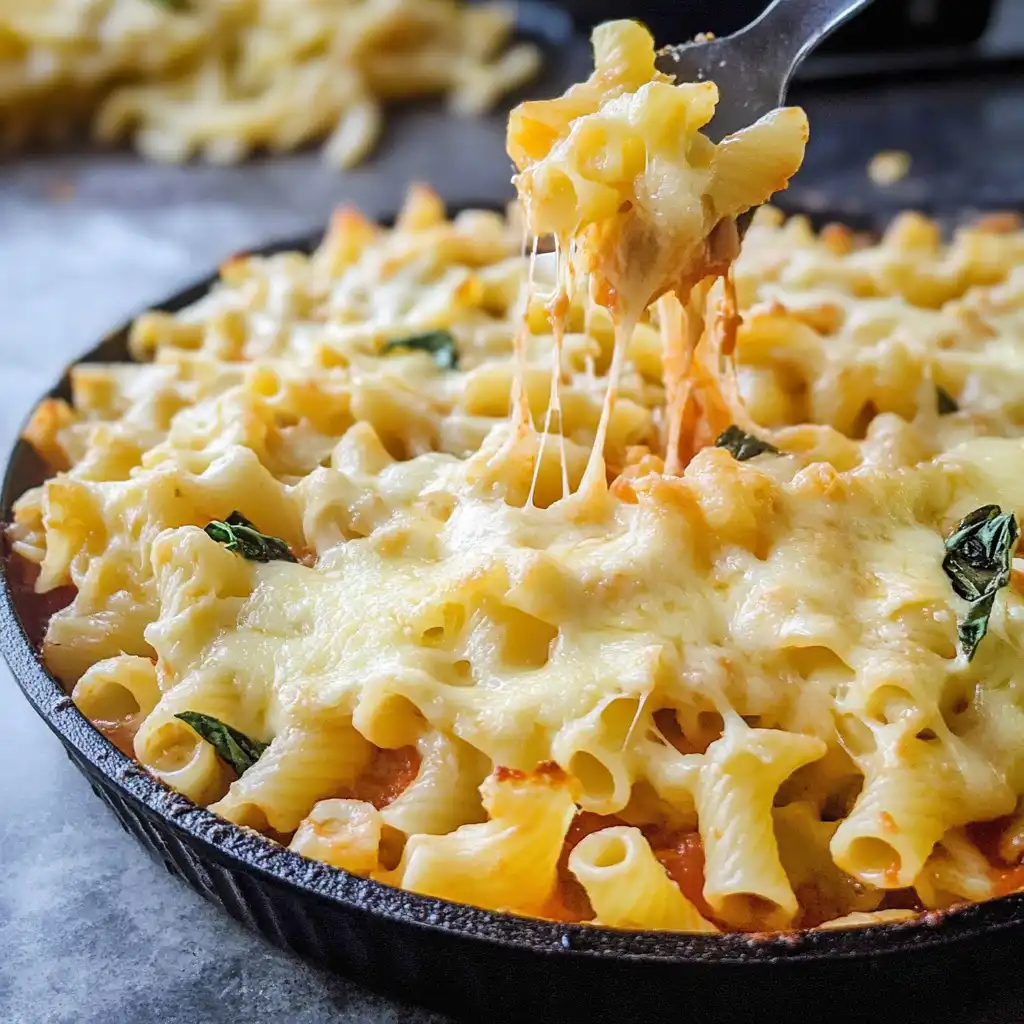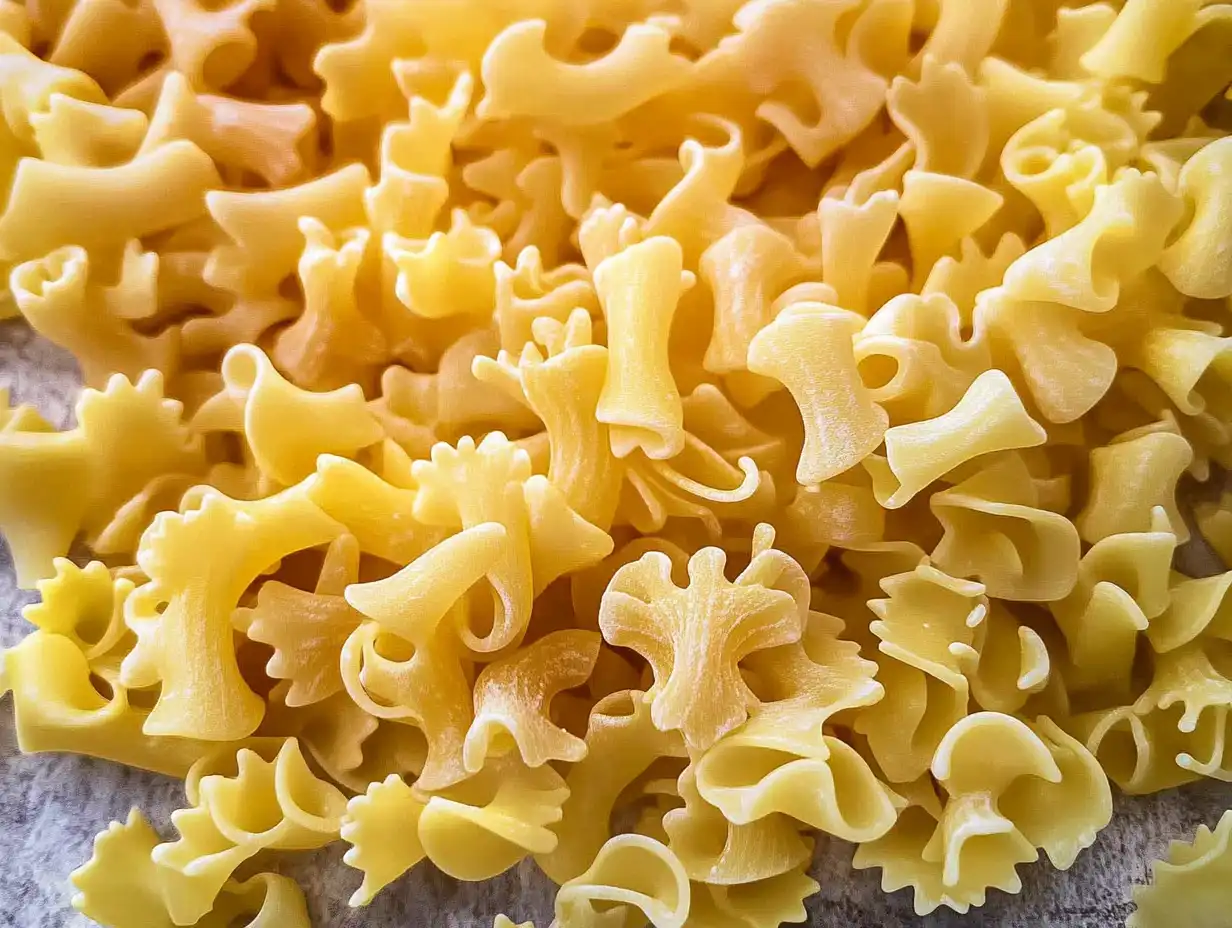Table of contents
Introduction
Pasta is a cornerstone of Italian cuisine, and among its many shapes and styles, gigli pasta stands out for its elegance and versatility. Known as “campanelle,” meaning “little bell” in Italian, this pasta shape features fluted edges that spiral into a conical form, reminiscent of a bell or a flower. Gigli pasta’s unique design is not just for aesthetics—it’s perfectly crafted to hold sauces, making every bite rich and flavorful.
Whether you’re preparing a classic Italian dish or experimenting with modern recipes, gigli pasta offers endless possibilities. In this article, we’ll dive deep into its origins, cooking techniques, recipe ideas, and more, ensuring you have everything you need to incorporate this delightful pasta into your culinary repertoire.
What Is Gigli Pasta?
Gigli pasta, pronounced “jee-lee,” is a type of pasta characterized by its delicate, ruffled shape. Its name, meaning “lilies” in Italian, reflects its floral design, which is as appealing to the eye as it is functional in cooking. Often referred to as campanelle in other regions, gigli pasta is crafted to pair beautifully with a wide variety of sauces, from thick, creamy options to light and tangy ones.
This pasta is typically made from durum wheat semolina, a high-protein flour that gives it a firm texture and ability to hold its shape during cooking. Available in both plain and flavored varieties, gigli pasta has become a favorite for chefs and home cooks alike due to its ability to elevate even the simplest dishes.
The History of Gigli Pasta
The origins of gigli pasta are deeply rooted in Italian culinary traditions. Its name, “gigli,” translates to “lily” in Italian and pays homage to Florence, where the lily is a prominent symbol. Some sources trace the pasta’s creation to the Tuscany region, celebrated for its artisanal pasta-making and visually striking culinary art.
Historically, gigli pasta was reserved for special occasions due to its intricate shape, which required skilled craftsmanship. In pre-industrial times, pasta makers manually shaped each piece, ensuring uniformity and precision. Over time, as pasta-making became mechanized, gigli pasta gained wider popularity, becoming more accessible to households across Italy and beyond.
Today, gigli pasta represents a fusion of tradition and modernity. While it retains its classic design, contemporary variations in flavor, color, and production methods make it a versatile choice in global cuisines. From Tuscan kitchens to fine dining establishments worldwide, gigli pasta continues to be celebrated for its elegance and practicality.
How to Cook Gigli Pasta
Cooking gigli pasta to perfection is both an art and a science. Its unique shape requires careful handling to ensure even cooking while preserving its texture and structure. Follow these steps for a flawless preparation:
Step 1: Gather Your Ingredients and Tools
- Gigli pasta: 1 cup per serving.
- Water: 4-6 quarts per pound of pasta.
- Salt: 1 tablespoon per quart of water.
- Optional: Olive oil to prevent sticking (though not usually necessary).
Step 2: Boil the Water
Fill a large pot with water and place it on high heat. Once it reaches a rolling boil, add the salt. The salted water enhances the flavor of the pasta.
Step 3: Cook the Pasta
Add gigli pasta to the boiling water, stirring gently to prevent clumping. Cook the pasta according to the package instructions, typically 10-12 minutes, for an al dente texture. Stir occasionally to ensure even cooking.
Step 4: Taste and Check
A minute or two before the recommended cooking time ends, taste a piece of pasta to check its texture. It should be firm yet tender, with no raw taste.
Step 5: Drain and Serve
Once cooked, drain the pasta in a colander and shake off excess water. If your recipe requires, reserve some pasta water to use in the sauce. Avoid rinsing the pasta unless preparing a cold dish, as rinsing can strip away the starches that help sauces adhere.
Best Sauces for Gigli Pasta

Gigli pasta’s ruffled edges and cone-like shape make it a champion at capturing sauces, ensuring every bite is flavorful. Its versatility allows it to pair beautifully with a wide variety of sauces. Here are some of the best options:
Cream-Based Sauces
Gigli pasta excels with rich, creamy sauces that cling to its folds. Popular options include:
- Alfredo Sauce: A classic blend of butter, heavy cream, and Parmesan cheese.
- Gorgonzola Cream Sauce: A tangy, cheesy delight made with Gorgonzola and cream.
- Mushroom Sauce: A savory combination of sautéed mushrooms, garlic, cream, and white wine.
Tomato-Based Sauces
The robust flavor of tomato-based sauces complements gigli pasta perfectly:
- Marinara: A simple and fresh sauce made with tomatoes, garlic, olive oil, and basil.
- Bolognese: A hearty meat sauce with tomatoes, ground beef, and aromatic herbs.
- Arrabbiata: A spicy tomato sauce infused with chili flakes and garlic.
Pesto and Oil-Based Sauces
Lighter sauces allow the pasta’s texture to shine:
- Basil Pesto: A bright, herbaceous sauce made with basil, pine nuts, garlic, and Parmesan.
- Garlic and Olive Oil (Aglio e Olio): A simple yet flavorful choice enhanced with red pepper flakes and parsley.
- Lemon Butter Sauce: A zesty, buttery option that’s perfect for seafood-inspired dishes.
Popular Recipes with Gigli Pasta

Gigli pasta’s unique shape makes it a standout in a wide variety of dishes, from hearty casseroles to light salads. Here are some popular recipes to inspire your next meal:
1. With Creamy Spinach and Mushroom Sauce
This vegetarian dish combines gigli pasta with a luscious cream sauce filled with sautéed mushrooms, fresh spinach, and Parmesan. It’s a comforting and indulgent option for weeknight dinners.
2. Baked with Meatballs
A crowd-pleaser, this recipe layers cooked gigli pasta with marinara sauce, mozzarella, and homemade meatballs, then bakes everything to perfection. The ruffled edges of the pasta soak up the sauce beautifully, making each bite irresistible.
3. Lemon Garlic with Shrimp
This refreshing dish pairs gigli pasta with sautéed shrimp, lemon zest, garlic, and olive oil. The light, citrusy flavors make it an excellent choice for summer meals.
Why Gigli Pasta Stands Out
Among the many pasta shapes available, gigli pasta distinguishes itself through its aesthetic appeal and functional versatility. Here’s what makes it a standout choice:
Unique Shape and Texture
Gigli pasta’s distinctive bell-like shape and ruffled edges aren’t just visually appealing—they’re designed to capture sauces, making every bite flavorful. The sturdy, slightly chewy texture ensures it holds up well in both light and hearty dishes.
Versatility in Dishes
Whether you’re preparing a creamy Alfredo, a tangy tomato sauce, or a cold pasta salad, gigli pasta adapts effortlessly. Its ability to transition from casual weeknight meals to elegant dinner parties makes it a favorite for home cooks and chefs alike.
Elegance with Practicality
Gigli pasta bridges the gap between artistry and functionality. Its ornamental design elevates the presentation of any dish, while its robust structure accommodates both thick sauces and chunky ingredients like vegetables and meats.
Traditional Yet Contemporary
Rooted in Italian culinary heritage, gigli pasta has managed to remain relevant in modern kitchens. Its adaptability to global cuisines and fusion recipes further cements its status as a timeless classic.
Nutritional Value
Gigli pasta, like most traditional pastas, is made from durum wheat semolina, which offers a balance of carbohydrates, proteins, and essential nutrients. Understanding its nutritional profile can help you incorporate it into a balanced diet:
Basic Nutritional Breakdown (Per 100g of Dry Pasta)
- Calories: Approximately 350 kcal
- Carbohydrates: 70-75g
- An excellent source of energy.
- Protein: 12-14g
- Supports muscle maintenance and repair.
- Fat: 1-2g
- Very low in fat, with minimal saturated fat.
- Fiber: 3-5g
- Aids in digestion and promotes gut health.
- Iron: 10-12% of the recommended daily intake
- Essential for oxygen transport in the blood.
Health Benefits
- Slow Energy Release: The complex carbohydrates in gigli pasta provide a steady source of energy, making it an excellent choice for sustaining physical activity.
- Low Glycemic Index: When cooked al dente, gigli pasta has a moderate glycemic index, which can help regulate blood sugar levels.
- Enriched Varieties: Many brands offer enriched gigli pasta fortified with additional nutrients like folic acid, making it suitable for diverse dietary needs.
Considerations for Specific Diets
- Gluten-Free Options: For those with gluten sensitivities or celiac disease, gigli pasta is available in gluten-free versions made from alternative flours like rice, quinoa, or chickpea.
- Whole Wheat Variants: Whole wheat gigli pasta offers higher fiber content and a nuttier flavor profile, ideal for those seeking a more health-conscious choice.
Substitutes for Gigli Pasta
Although gigli pasta is uniquely shaped, there are several substitutes available if it’s not accessible. These alternatives can replicate its ability to hold sauces and provide similar textures in recipes:
1. Campanelle
Gigli pasta is often interchangeable with campanelle, as they are essentially the same shape. If it’s labeled as campanelle, you can confidently use it in any recipe.
2. Fusilli
Fusilli’s spiral design mimics gigli’s ability to trap sauces effectively. It’s a great substitute for both creamy and chunky sauces.
3. Penne
Penne’s tubular shape holds thick sauces well, making it a practical replacement in baked dishes or hearty recipes.
4. Conchiglie (Shells)
Shell pasta, with its concave structure, is ideal for capturing rich sauces, making it a versatile substitute for gigli pasta in creamy and cheesy dishes.
5. Farfalle
While different in shape, farfalle (bow-tie pasta) provides a similar visual appeal and works well with light or chunky sauces.
6. Rigatoni
For baked recipes, rigatoni’s robust, ridged design performs similarly to gigli pasta, holding onto sauces and cheese beautifully.
Gigli Pasta in Italian Cuisine
Gigli pasta holds a special place in Italian culinary traditions, particularly in regions that celebrate artisanal pasta-making. Here’s how it’s integrated into Italy’s rich culinary tapestry:
A Tuscan Specialty
Gigli pasta is believed to have originated in Tuscany, where the artistry of pasta-making is revered. Its floral design symbolizes the lily, Florence’s emblem, making it a regional icon. It’s often paired with classic Tuscan sauces, such as wild boar ragu or tomato-based sugo.
Festive and Celebratory Dishes
Historically, gigli pasta was reserved for special occasions due to the labor-intensive process of shaping it by hand. Even today, it is featured in celebratory meals, such as weddings and holidays, where its ornate appearance adds a touch of elegance to the table.
A Versatile Choice
Italian chefs and home cooks appreciate gigli pasta’s adaptability. In Northern Italy, it might be paired with cream-based sauces or mushroom ragus, while in the South, it could feature in spicy arrabbiata or seafood-based dishes.
Modern Italian Fusion
While firmly rooted in tradition, gigli pasta has found a place in modern fusion cuisine. Italian-American chefs have popularized dishes like baked gigli casseroles and cold pasta salads, showcasing its versatility beyond traditional recipes.
Tips for Storing Gigli Pasta
Proper storage of gigli pasta ensures its freshness and quality, whether it’s uncooked or leftover from a meal. Here are some best practices:
Storing Uncooked
- Keep It Dry: Store gigli pasta in an airtight container to protect it from moisture, which can cause spoilage or clumping.
- Avoid Direct Sunlight: Place the container in a cool, dry cupboard away from heat and sunlight to maintain its texture and flavor.
- Check Expiry Date: If using packaged pasta, keep an eye on the expiration date and rotate stock to use the oldest packages first.
Freezing Uncooked Pasta
Although not common, you can freeze uncooked gigli pasta to extend its shelf life. Seal it in a freezer-safe bag, removing as much air as possible to prevent freezer burn. Use within 6-8 months for best quality.
Storing Cooked Gigli Pasta
- Refrigeration: Place it cooked in an airtight container or resealable bag and refrigerate within two hours of cooking. It should be consumed within 3-5 days.
- Add a Drizzle of Oil: To prevent clumping, toss the pasta with a small amount of olive oil before refrigerating.
- Freezing Cooked: When it’s cooked it can be frozen for up to 2 months. Store it with sauce for better reheating results, as the sauce helps maintain its texture.
Where to Buy Gigli Pasta
Gigli pasta is widely available in specialty stores and online, making it accessible for pasta enthusiasts worldwide. Here’s where you can find it:
Local Grocery Stores
- Specialty Italian Shops: Italian markets often stock authentic gigli pasta made by artisanal brands. Look for pasta imported from Italy for the best quality.
- Premium Grocery Chains: Upscale supermarkets like Whole Foods or Trader Joe’s may carry gigli pasta, often labeled as “campanelle.”
- Health Food Stores: Stores focusing on organic or gluten-free products may offer gigli pasta made from alternative flours, such as chickpea or brown rice.
Online Retailers
- Amazon: A vast selection of gigli pasta, including flavored and organic varieties, is available on Amazon with user reviews to guide your choice.
- Specialty Websites: Online platforms like Eataly and Pastificio sell high-quality Italian gigli pasta and often provide recipes for inspiration.
- Subscription Services: Pasta subscription boxes often include unique shapes like gigli, along with pairing ideas and sauces.
Farmers’ Markets
In some regions, you can find homemade or locally produced gigli pasta at farmers’ markets. These often offer a fresh, artisanal touch that elevates your dishes.
Tips for Buying
- Check the Ingredients: Opt for pasta made from durum wheat semolina for the best texture and flavor.
- Inspect the Packaging: Ensure the packaging is sealed and free from visible damage.
- Explore Flavored Options: Look for varieties infused with spinach, tomato, or squid ink for a colorful and flavorful twist.
FAQs
What kind of pasta is a Gigli?
Gigli pasta, also known as “Campanelle,” is a unique, bell-shaped pasta with frilly edges. Its design makes it ideal for holding sauces, whether creamy, chunky, or tomato-based, making it versatile for a variety of dishes.
What is the meaning of Gigli pasta?
The word “Gigli” translates to “lilies” in Italian, symbolizing the flower-like or bell-shaped design of this pasta. It reflects both the artistry and cultural heritage of Italian cuisine.
Where is Gigli pasta from?
Gigli pasta originates from Tuscany, Italy. Its elegant shape was inspired by the region’s artistic traditions and is often associated with celebrations and festive meals in Italian culture.
What is Gigli pasta?
Gigli pasta is a delightful type of Italian pasta known for its bell-like shape and frilly edges. It is crafted from durum wheat semolina and is designed to hold sauces exceptionally well, making it a favorite in traditional and modern recipes.
What is the difference between gigli pasta and campanelle?
Gigli pasta and campanelle are the same shape but have different names depending on the region or manufacturer. Both terms refer to the bell- or flower-shaped pasta with ruffled edges.
Can I use gigli pasta in baked dishes?
Yes! Gigli pasta is excellent for baked dishes like casseroles. Its shape holds up well under high heat and captures sauces, cheese, and other ingredients beautifully.
How is gigli pasta traditionally served in Italy?
In Italy, is often served with rich, meaty sauces such as wild boar ragu or creamy mushroom-based sauces. It is also a popular choice for festive dishes.
Is gigli pasta gluten-free?
Traditional gigli pasta is made from durum wheat semolina, which contains gluten. However, gluten-free versions are available, made from alternative flours like rice, quinoa, or chickpea.
How long does gigli pasta take to cook?
Typically cooks in 10-12 minutes for an al dente texture. Always check the package instructions for precise cooking times.
What makes gigli pasta ideal for creamy sauces?
The ruffled edges and cone shape, capture creamy sauces perfectly, ensuring each bite is flavorful and satisfying.
Related Recipes and Culinary Ideas
If you’re exploring recipes, you might find these related ideas from Greedy Recipes helpful to elevate your culinary experience:
- Green Spaghetti: A Delicious Twist to Classic Pasta: Learn how to incorporate unique flavors and techniques that can inspire your Gigli Pasta creations.
- What is the Closest Pasta to Ditalini?: Discover pasta alternatives that share similar textures, perfect for experimenting with Gigli in various recipes.
- What is Capellini D’Angelo Pasta? A Comprehensive Guide: Compare different pasta types, including how Gigli stands out in texture and flavor profiles.
These resources offer both inspiration and practical tips to make your next Gigli Pasta dish unforgettable!
Conclusion
Gigli pasta, with its unique bell-shaped design and rich culinary history, is a true gem of Italian cuisine. Its versatility allows it to pair beautifully with a wide range of sauces, from creamy Alfredo to tangy tomato-based options. Whether you’re crafting a comforting baked dish or a refreshing pasta salad, gigli pasta’s ability to hold flavors and sauces makes it an excellent choice for any meal.
From its origins in Tuscany to its popularity in global kitchens, gigli pasta represents a fusion of tradition and modernity. Its elegant shape and robust texture make it ideal for elevating both simple and sophisticated dishes. By mastering its preparation, storage, and pairing options, you can unlock endless possibilities with this delightful pasta. Whether you’re a seasoned chef or a home cook, gigli pasta is a must-try for your next culinary adventure.
